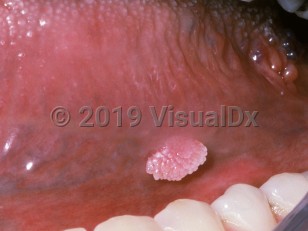Oral papilloma - Oral Mucosal Lesion
Alerts and Notices
Important News & Links
Synopsis

Oral papilloma is also known as squamous papilloma caused by human papillomavirus (HPV). It presents as a slow-growing, cauliflower-like lesion in the oral cavity. Oral papilloma occurs in about 1 of every 250 adults, most often during the third to fifth decades. It also accounts for 8% of oral tumors in children. Virus subtypes 6 and 11 have been identified in 50% of these lesions. The mode of transmission is unknown, but the viruses in this condition appear to have low virulence and infectivity rate. Any oral surface can be affected, but it most commonly appears on the tongue, lips, and soft palate.
Codes
ICD10CM:
B07.8 – Other viral warts
D10.30 – Benign neoplasm of unspecified part of mouth
SNOMEDCT:
402908003 – Oral wart
B07.8 – Other viral warts
D10.30 – Benign neoplasm of unspecified part of mouth
SNOMEDCT:
402908003 – Oral wart
Look For
Subscription Required
Diagnostic Pearls
Subscription Required
Differential Diagnosis & Pitfalls

To perform a comparison, select diagnoses from the classic differential
Subscription Required
Best Tests
Subscription Required
Management Pearls
Subscription Required
Therapy
Subscription Required
References
Subscription Required
Last Reviewed:01/01/2024
Last Updated:01/11/2024
Last Updated:01/11/2024

